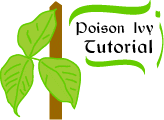

I use Fels Naptha bar laundry soap, after my friend's Grandmother pointed it out. You wet down the bar of soap, lather it on, and let it dry (do not rinse off). Every time the poison ivy starts to itch, you can use the wet bar of soap to somewhat safely scratch the spot (ok, I confess I don't think that's the intention, but well, I'm one of those compulsive poison ivy scratchers), and the soap dries out the area.
A poison ivy rash does *not* spread. That's a common misconception. The rash will break out where you first touched the plant, and will slowly break out to where the resin was also in contact with your skin. It looks like the rash is "spreading", but it's merely just appearing where you were already infected. Itching does not "spread" the rash. Itching can cause secondary bacterial infections, which are equally nasty.
Should your rash start to "weep", that is, leak semi-clear yellowish liquid from the spots where you've scratched, or even where you haven't scratched the rash, that's a good sign, because it means your case is actually progressing through its cycle. It's important to wash that weeping off with soap (regular or dish soap) and cool/cold water, and to keep your rash clean.
Aloe vera and vitamin E will help your skin heal, and you should not pick at scabs, but rather soften them with lotions.
Tom Brown's Guide to Wild and Medicinal Plants (1985, ISBN 0-425-10063-4) lists acorn tea, birch tea, bulrush, burdock, cattail, chicory, comfrey, hemlock, jewelweed, milkweed, mint, spicebush, sumac (staghorn, not poison obviously), sweet fern, thistle tea, and yucca. The guide is a fantastic and entertaining reference on how to use plants for a number of things, and I leave looking up each of these plants to you. (I also recommend any of the books by Tom Brown, Jr. He has an entire series of outdoor guides that are extremely informative and entertaining reading. I really enjoyed attending his Basic Tracking and Wilderness Survival course, though it was expensive.)
A reader adds: "You would do well to mention on the home remedies page that temporary relief from the itching can be obtained by getting in the shower and holding your blisters in the stream while setting the water flow to the hottest temperature you can stand. I have been hyperallergic since 1948, and this is gives me more effective relief than anything else, including cortisone shots."
Another reader points out that Vitamin C powder, when mixed with water into a paste and applied, helps. The reference link is here (this link leaves my site), scan down a bit to get to the poison ivy information.
Another reader adds:
"I would not have believed it if I had not seen it for myself, but walnuts can make a huge difference.
My daughter caught a BAD case of poison ivy. She had a red rash, unbroken, with red welts or
scratches, across her entire lower back, from one side to the other. She also had some rash on her arms.
A friend of mine from West Virginia told me that walnuts can ease the itch within a few minutes
and make the rash go away overnight.
Luckily, he has some walnut trees on his property. He knocked down three of them.
Unfortunately, it's early in the season, so the husks are relatively thin and dry,
unlike in the fall when just touching one on the ground can leave your hands stained.
I took a knife and cut away the outer skin of one of the walnuts. When the juice of the husk
began to come to the surface, I wiped it on her rash. It did sting/burn some, and the burning
of the rash didn't really go away completely, but it did ease. In the morning, the redness on
her left side was gone. The scratches were still there, as well as the rash on her right lower back.
I peeled the other two walnuts and spread the available juice (though there wasn't much of it available
because the fruits were still so unripened) over the remaining rash on her back and arms.
By the next day, there was again a remarkable improvement. It didn't all go away, but most of it did.
To treat the rest of rash and discomfort, we used "Mean Green" by spraying a little on cotton pads and rubbing on the rash.
(Reportedly it contains the same ingredients as Zanfel, and inspired the creation of Zanfel.) Regardless,
it makes the itching and burning go away for a long time, 9-12 hours usually -- much longer than either
Itch-X or hydrocortisone cream.
After a week, her rash is dried up and the discomfort is gone.
Thanks for your GREAT site. Wanted to share what has actually worked. Hope this helps!."
Next: Urushiol Resin and Clothes
Back to the Poison Ivy Tutorial.